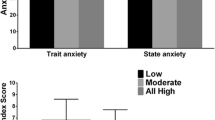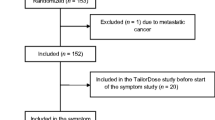Abstract
Purpose
Insights into the severity of co-existing symptoms can help in identifying breast cancer survivors in need of symptom management. We aimed to identify subgroups of breast cancer survivors based on patterns of symptom severity, and characteristics associated with these subgroups.
Methods
We selected surgically treated stage I–III breast cancer survivors 1–5 years post-diagnosis from the Netherlands Cancer Registry (N = 876). We assessed experienced severity of fatigue, nausea, pain, dyspnea, insomnia, appetite, constipation, diarrhea, and emotional and cognitive symptoms through the EORTC-QLQ-C30 Quality of Life Questionnaire on a scale of 0–100. We determined subgroups of survivors using latent class cluster analyses (LCA) based on severity of co-existing symptoms and compared their mean severity to the age-matched female reference population to interpret clinical relevance. We assessed subgroup characteristics by multinomial logistic regression analyses.
Results
From 404 respondents (46%), three subgroups of survivors with distinct symptom severity were identified: low severity (n = 116, 28.7%), intermediate severity (n = 224, 55.4%), and high severity (n = 59, 14.6%). The low subgroup reported lower symptom severity than the general population; the intermediate subgroup reported a similar symptom severity, although scores for fatigue, insomnia, and cognitive symptoms were worse (small-medium clinical relevance). The high subgroup had worse symptom severity (medium-large clinical relevance). Compared to the intermediate subgroup, one (RRR: 2.75; CI: 1.22–6.19; p = 0.015) or more (RRR: 9.19; CI: 3.70–22.8; p = < 0.001) comorbidities were significantly associated with the high subgroup. We found no associated treatment characteristics.
Conclusion
We identified distinct subgroups of breast cancer survivors based on symptom severity, underlining the relevance of further exploring personalized follow-up strategies.

Similar content being viewed by others
Data availability
The data that support the findings of this study are available from the Netherlands Cancer Registry but restrictions apply to the availability of these data, which were used under license for the current study, and so are not publicly available. Data are however available from the authors upon reasonable request and with permission of the Netherlands Cancer Registry.
Code availability
Codes written in Latent GOLD version 5.2.0; Stata/SE 14.2. Codes are available at the corresponding author upon reasonable request.
References
Surbone A, Tralongo P (2016) Categorization of cancer survivors: why we need it. J Clin Oncol 34(28):3372–3374
Wu HS, Harden JK (2015) Symptom burden and quality of life in survivorship: a review of the literature. Cancer Nurs 38(1):E29–E54
Schmidt ME, Wiskemann J, Steindorf K (2018) Quality of life, problems, and needs of disease-free breast cancer survivors 5 years after diagnosis. Qual Life Res 27:2077–2086
Bjørklund Ellegaard MB et al (2017) Women with breast cancer report substantially more disease and treatment-related side or late effects than registered by clinical oncologists: a cross-sectional study of a standard follow-up program in an oncological department. Breast Cancer Res Treat 164:164
Arndt V et al (2017) Quality of life in long-term and very long-term cancer survivors versus population controls in Germany. Acta Oncol 56(2):190–197
de Ligt KM et al (2019) The impact of health symptoms on health-related quality of life in early-stage breast cancer survivors. Breast Cancer Res Treat 178:703–711
Doege D et al (2019) Health-related quality of life in long-term disease-free breast cancer survivors versus female population controls in Germany. Breast Cancer Res Treat 175:499–510
Mols F et al (2005) Quality of life among long-term breast cancer survivors: a systematic review. Eur J Cancer 41:2613–2619
Peuckmann V et al (2006) Health-related quality of life in long-term breast cancer survivors: nationwide survey in Denmark. Breast Cancer Res Treat 104:39–46
Koch L et al (2013) Quality of life in long-term breast cancer survivors – a 10-year longitudinal population-based study. Acta Oncol 52(6):1119–1128
Runowicz CD et al (2016) American Cancer Society/American Society of clinical oncology breast cancer survivorship care guideline. CA Cancer Soc J Clin Oncol 66:43–73
Cardoso F et al (2019) Early breast cancer: esmo clinical practice guidelines. Ann Oncol 30:1194–1220
Cruickshank S, Barber M (2019) Breast cancer follow-up after a primary diagnosis: a confused picture. The Breast 46:97–100
Zorginstituut Nederland (2016) Verbetersignalement Zinnige nacontrole bij vrouwen behandeld voor borstkanker. Diemen. Accessed at: https://www.zorginstituutnederland.nl/binaries/zinl/documenten/rapport/2016/10/31/zinnige-zorg-verbetersignalement-zinnige-nacontrole-bij-vrouwen-behandeld-voor-borstkanker/Verbetersignalement+Zinnige+nacontrole+bij+vrouwen+behandeld+voor+borstkanker.pdf
Fallowfield L, Jenkins V (2014) Psychosocial/survivorship issues in breast cancer: are we doing better? J Natl Cancer Inst 107(1):335. https://doi.org/10.1093/jnci/dju335
Ruban PU et al (2018) Patient evaluation of breast cancer follow-up: a Danish survey. Patient Educ Couns 101(1):99–104
Mayer DK, Nasso SF, Earp JA (2017) Cancer survivorship in the USA: defining cancer survivors, their needs, and perspectives on survivorship health care in the USA. Lancet Oncol 18:e11-18
Miaskowski C et al (2007) Conceptual issues in symptom clusters research and their implications for quality-of-life assessment in patients with cancer. J Natl Cancer Inst Monogr 37:39–46
Miaskowski C et al (2017) Advancing symptom science through symptom cluster research: expert panel proceedings and recommendations. J Natl Cancer Inst 109(4):dgw253
Brant JM, Beck S, Miaskowski C (2010) Building dynamic models and theories to advance the science of symptom management research. J Adv Nurs 66(1):228–240
Nguyen J et al (2011) A literature review of symptom clusters in patients with breast cancer. Expert Rev Pharmacoecon Outcomes Res 11(5):533–539
Nho JH et al (2018) Symptom clusters and quality of life in breast cancer survivors after cancer treatment in a tertiary hospital in Korea. Eur J Cancer Care (Engl) 27(6):e12919
Lee LJ et al (2020) Symptom clusters in breast cancer survivors: a latent class profile analysis. Oncol Nurs Forum 47(1):89–100
St Fleur RG et al (2021) A latent profile analysis to assess physical, cognitive and emotional symptom clusters in women with breast cancer. Psychol Health 1–17. https://doi.org/10.1080/08870446.2021.1941960
Berger AM et al (2020) Symptom clusters and quality of life over 1 year in breast cancer patients receiving adjuvant chemotherapy. Asia Pac J Oncol Nurs 7(2):134–140
Aaronson NK et al (1993) The European Organisation for Research and Treatment of Cancer QLQ-C30: a quality-of-life instrument for use in international clinical trials in oncology. J Natl Cancer Inst 85:365–376
de Ligt KM et al (2019) Patient-reported health problems and healthcare use after treatment for early-stage breast cancer. The Breast 46:4–11
Netherlands Cancer Registry, hosted by Netherlands Comprehensive Cancer Organisation (IKNL) Editor: Utrecht, The Netherlands
van de Poll-Franse LV et al (2011) The Patient Reported Outcomes Following Initial treatment and Long term Evaluation of Survivorship registry: scope, rationale and design of an infrastructure for the study of physical and psychosocial outcomes in cancer survivorship cohorts. Eur J Cancer 47(14):2188–2194
van de Poll-Franse LV et al (2011) Normative data for the EORTC QLQ-C30 and EORTC-sexuality items in the general Dutch population. Eur J Cancer 47:667–675
Giesinger JM et al (2016) Replication and validation of higher order models demonstrated that a summary score for the EORTC QLQ-C30 is robust. J Clin Epidemiol 69:79–88
Kenyon M, Mayer DK, Owens AK (2014) Late and long-term effects of breast cancer treatment and surveillance management for the general practitioner. J Obstet Gynecol Neonatal Nurs 43:382–398
Sangha O et al (2003) The Self-Administered Comorbidity Questionnaire: a new method to assess comorbidity for clinical and health services research. Arthritis Rheum 49(2):156–163
Vermunt JK (2005) Latent GOLD 4.0 User’s Guide. Statistical Innovations Inc, Belmont
Vermunt JK, Magidson J (2002) Latent class cluster analysis. In: Hagenaars J, McCutcheon A (eds) Applied latent class analysis. Cambridge University Press, Cambridge, pp 89–106
Chu W et al (2016) Determinants of quality of life among long-term breast cancer survivors. Qual Life Res 25(8):1981–1990. https://doi.org/10.1007/s11136-016-1248-z
Cocks K et al (2011) Evidence-based guidelines for determination of sample size and interpretation of the European Organisation for the Research and Treatment of Cancer Quality of Life Questionnaire Core 30. J Clin Oncol 29:89–96
StataCorp, (2015) Stata Statistical Software: Release 14. StataCorp LP, College Station
Avis NE et al (2017) Longitudinal examination of symptom profiles among breast cancer survivors. J Pain Symptom Manage 53(4):703–710
Bjerkeset E, Röhrl K, Schou-Bredal I (2020) Symptom cluster of pain, fatigue, and psychological distress in breast cancer survivors: prevalence and characteristics. Breast Cancer Res Treat 180:63–71
Pinheiro LC et al (2017) Examining health-related quality of life patterns in women with breast cancer. Qual Life Res 26:1733–1743
Kwekkeboom KL (2016) Cancer symptom cluster management. Semin Oncol Nurs 32(4):373–382
Barsevick AM (2007) The elusive concept of the symptom cluster. Oncol Nurs Forum 34(5):971–980. https://doi.org/10.1188/07.ONF.971-980
Bender CM et al (2005) Symptom clusters in breast cancer across 3 phases of the disease. Cancer Nurs 28(3)
Allemani C et al (2018) Global surveillance of trends in cancer survival 2000–14 (CONCORD-3): analysis of individual records for 37 513 025 patients diagnosed with one of 18 cancers from 322 population-based registries in 71 countries. Lancet 391(10125):1023–1075
Sung H et al (2021) Global Cancer Statistics 2020: GLOBOCAN estimates of incidence and mortality worldwide for 36 cancers in 185 countries. CA Cancer J Clin 71(3):209–249
Kirshbaum MN et al (2017) Open access follow-up care for early breast cancer: a randomised controlled quality of life analysis. Eur J Cancer Care 26:e12577
Iyer R, Ring A (2017) Breast cancer survivorship: key issues and priorities of care. Br J Gen Pract 67:140–141
Greenhalgh J (2009) The applications of PROs in clinical practice: what are they, do they work, and why? Qual Life Res 18:115–123
Oemrawsingh A et al (2020) Patient-reported morbidity instruments: a systematic review. Value in Health 23(6):791–811
Acknowledgements
The authors thank all women who participated in completing the survey.
Author information
Authors and Affiliations
Contributions
Conceptualization: K.M. de Ligt, B.H. de Rooij, I. Walraven, M.J. Heins, J. Verloop, S. Siesling, J.C. Korevaar, L.V. van de Poll-Franse.
Methodology: K.M. de Ligt, B.H. de Rooij, I. Walraven, M.J. Heins, J. Verloop, S. Siesling, J.C. Korevaar, L.V. van de Poll-Franse.
Formal analyses and investigation: K.M. de Ligt, B.H. de Rooij.
Writing – original draft preparation: K.M. de Ligt.
Writing – review and editing: B.H. de Rooij, I. Walraven, M.J. Heins, J. Verloop, S. Siesling, J.C. Korevaar, L.V. van de Poll-Franse.
All authors have read and approved the final version of the manuscript to be published. The authors ensure that questions related to the accuracy or integrity of any part of the work are appropriately investigated and resolved.
Corresponding author
Ethics declarations
Ethics approval
The use of data from the Netherlands Cancer Registry (NCR) was approved by the NCR Privacy Review Board. Formal ethical approval was not required, as the Dutch Medical Research (Human Subjects) Act did not apply for this study.
Consent to participate
Informed consent was obtained from all individual participants included in the study. Participants gave consent for processing their coded responses and merging these with their clinical data available in the NCR.
Consent for publication
Not applicable.
Competing interests
The authors declare no competing interests.
Additional information
Publisher's note
Springer Nature remains neutral with regard to jurisdictional claims in published maps and institutional affiliations.
Plain English language summary.
Many breast cancer survivors suffer from symptoms that may have been caused by the cancer and treatment. To date, these symptoms have been researched as separate symptoms. However, cancer survivors often suffer from multiple symptoms at the same time. We aimed to identify groups of breast cancer survivors based on their overall symptom burden. We found three subgroups of survivors, with either lower, comparable, or higher symptom burden than the general population. We also investigated which characteristics were associated with these subgroups. We found that patients with other diseases besides breast cancer had an increased risk for high symptom burden.
Rights and permissions
About this article
Cite this article
de Ligt, K.M., de Rooij, B.H., Walraven, I. et al. Varying severities of symptoms underline the relevance of personalized follow-up care in breast cancer survivors: latent class cluster analyses in a cross-sectional cohort. Support Care Cancer 30, 7873–7883 (2022). https://doi.org/10.1007/s00520-022-07229-6
Received:
Accepted:
Published:
Issue Date:
DOI: https://doi.org/10.1007/s00520-022-07229-6




